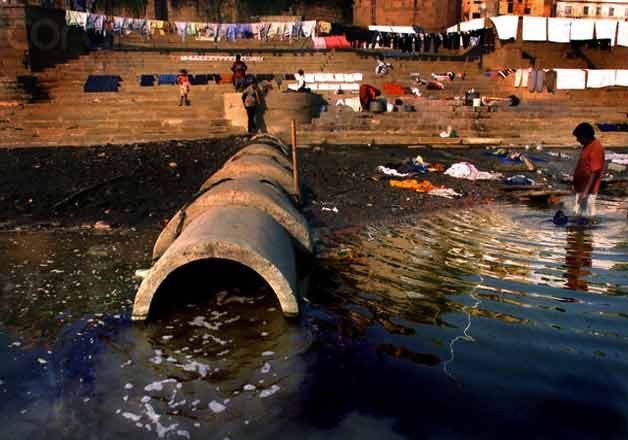Comprehensive Plan to Stop Ganga Sewage Spills Needed
Published on by Water Network Research, Official research team of The Water Network in Government
Just spending money on Sewage Treatment Plants (STPs) will not clean the Ganga river - what is needed is a comprehensive plan to stop sewage from entering the river, say experts.
 Their views assume significance in the light of the National Green Tribunal (NGT) pulling up government agencies for "wasting public money" in the name of cleaning the river.
Their views assume significance in the light of the National Green Tribunal (NGT) pulling up government agencies for "wasting public money" in the name of cleaning the river.
Not a single drop of the river has been cleaned so far," a bench headed by its Chairperson Justice Swatanter Kumar said.
Reputed water conservationist Rajendra Singh can only agree and he says that "distributing money for setting up machines" (STPs) won't bring good results unless there was a national protocol to stop sewage water from flowing into our rivers.
Environmentalist C.R. Babu concurred, saying all the rivers and rivulets flowing in the Gangetic plan carry only sewage and no river can be cleaned minus simultaneous efforts to clean towns and cites of sewage.
Sushmita Sengupta of the Centre for Science and Environment (CSE), however, felt that while the central government had an elaborate plan to clean the Ganga, concrete action on the field was still awaited.
 Rajendra Singh, known as the "Waterman of India", contended that the money spent on cleaning the Ganga was being "distributed" to contractors and companies with no experience in the field of river rejuvenation.
Rajendra Singh, known as the "Waterman of India", contended that the money spent on cleaning the Ganga was being "distributed" to contractors and companies with no experience in the field of river rejuvenation.
"They have given money for projects to install STPs. This money will go to those supplying iron, cement, concrete, pipes. But won't solve the problem," Singh told IANS.
"To comprehensively treat the river, there is need to ensure that dirty water does not find its way into Ganga, to separate all the 'nullahs' (drains) that merge with Ganga, to pass a law or formulate a national protocol to separate river from sewer," he added.
Singh, who won the Stockholm Water Prize (known as the Nobel Prize for water) in 2015, said: "What we need is to establish a system to ensure that dirty water doesn't mix with clean water. As for the dirty water, it should be treated and reused in agriculture, gardening, industry."
Read more at: The Economic Times
Media
Taxonomy
- Raw Sewage
- Treatment
- Sewage Treatment
- River Studies
- Ecosystem Management
- River Engineering
- Sewage
- River Restoration
- Public Health
- Ecosystem
- Sewage & Allied Waste
2 Comments
-
This is not rocket science. It appears that the strategy for cleaning the Ganga is being rolled out by amateurs with little practical experience. The process was well understood in the UK by the turn of the century (1900) and has been exported all over the world. Local collection systems are intercepted before they enter a watercourse and end up at a treatment facility which then discharges treated effluent to a watercourse or to agriculture. The gap in incomplete systems, which results in the discharge of untreated sewage is often only exceeded by the lack of maintenance once the systems have been constructed.
There is another fundamental issue which does not appear to have been addressed - to start at the top or the bottom? Most projects start at the bottom of the system as that is where the biggest sources of pollution are situated. However this means that no improvement is apparent until the whole project is complete. Starting at the top results in rapid improvement of the upper reaches which are apparent and serve as a spur to progress. The contrast between the improved upstream river and the unimproved stretch downstream serves to highlight the main sources of the pollution at the margin and what needs to be done next.
-
Ideal solution to prevent sewage from entering Ganga is Non Centralized Solar Thermal Evaporators.